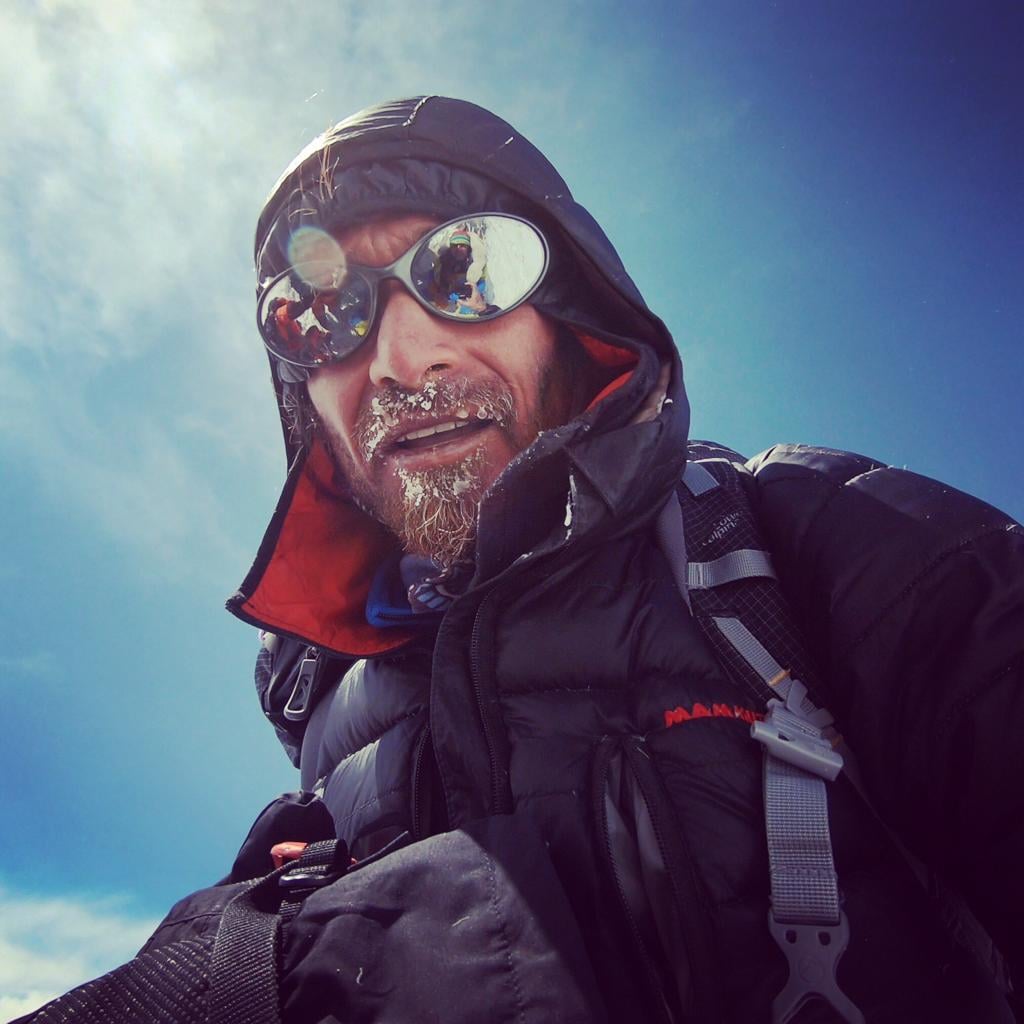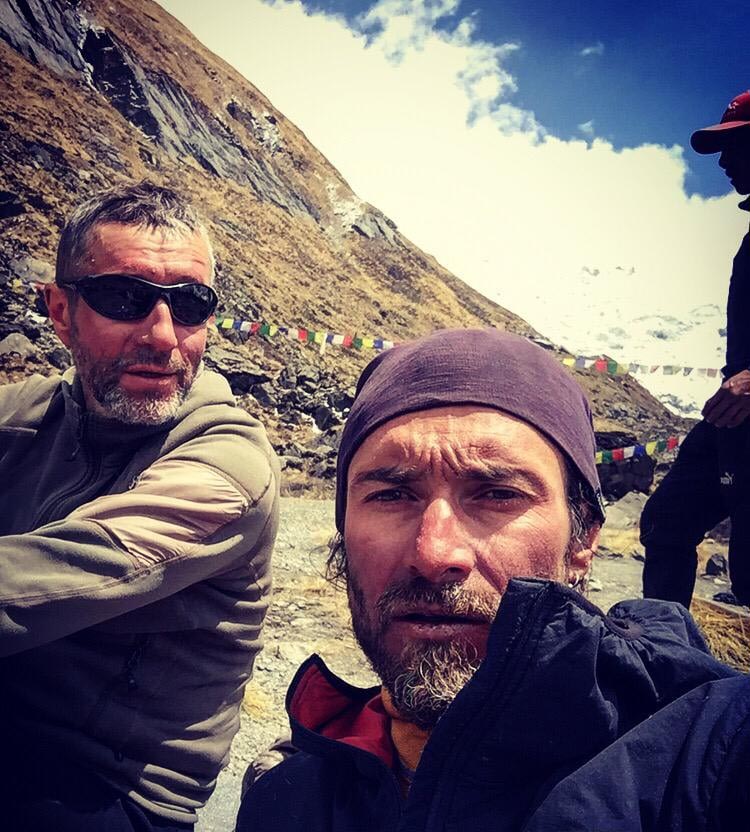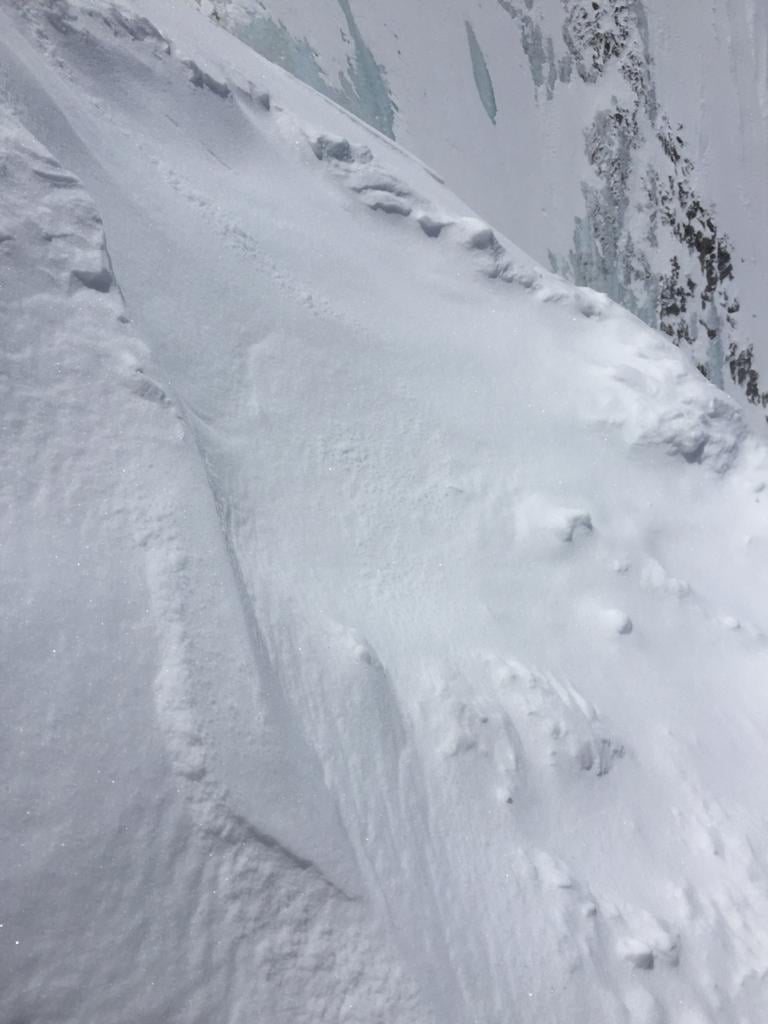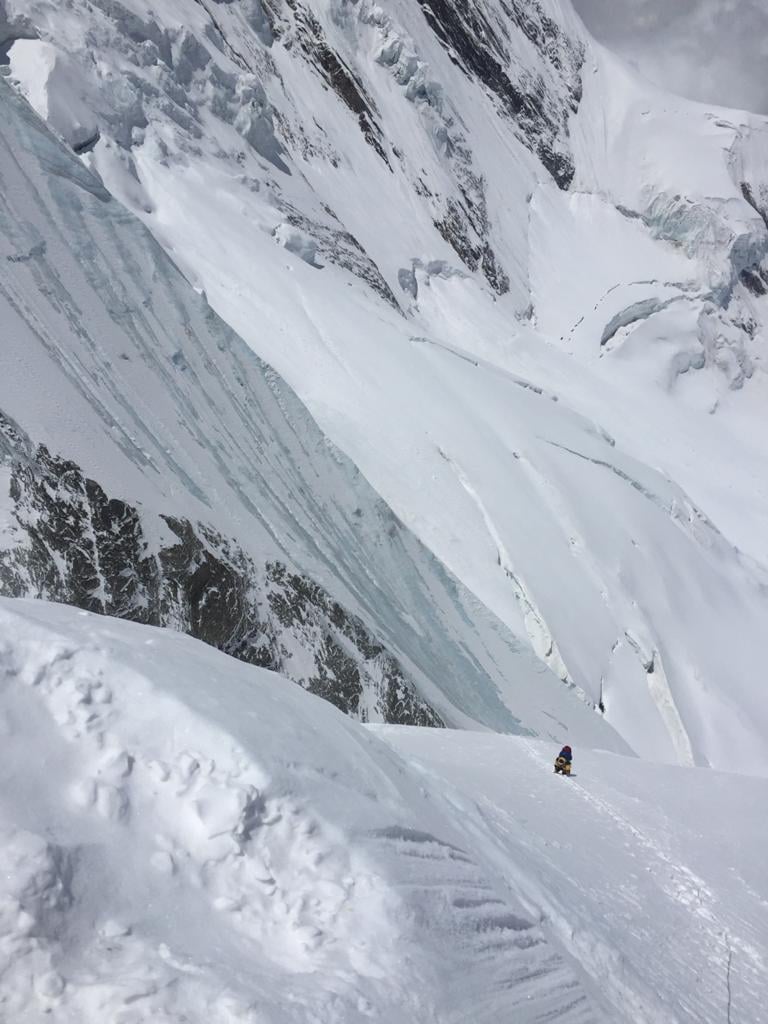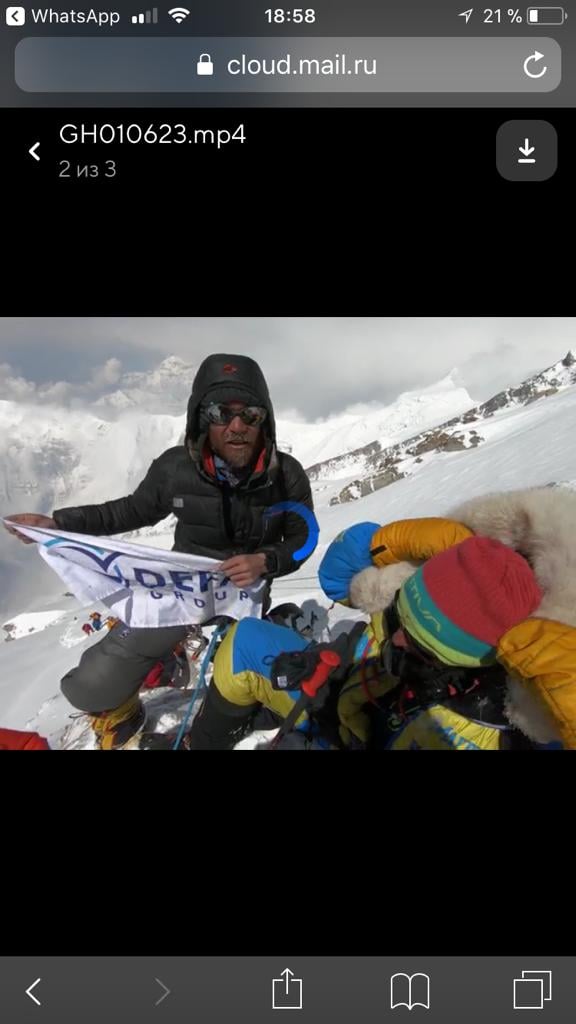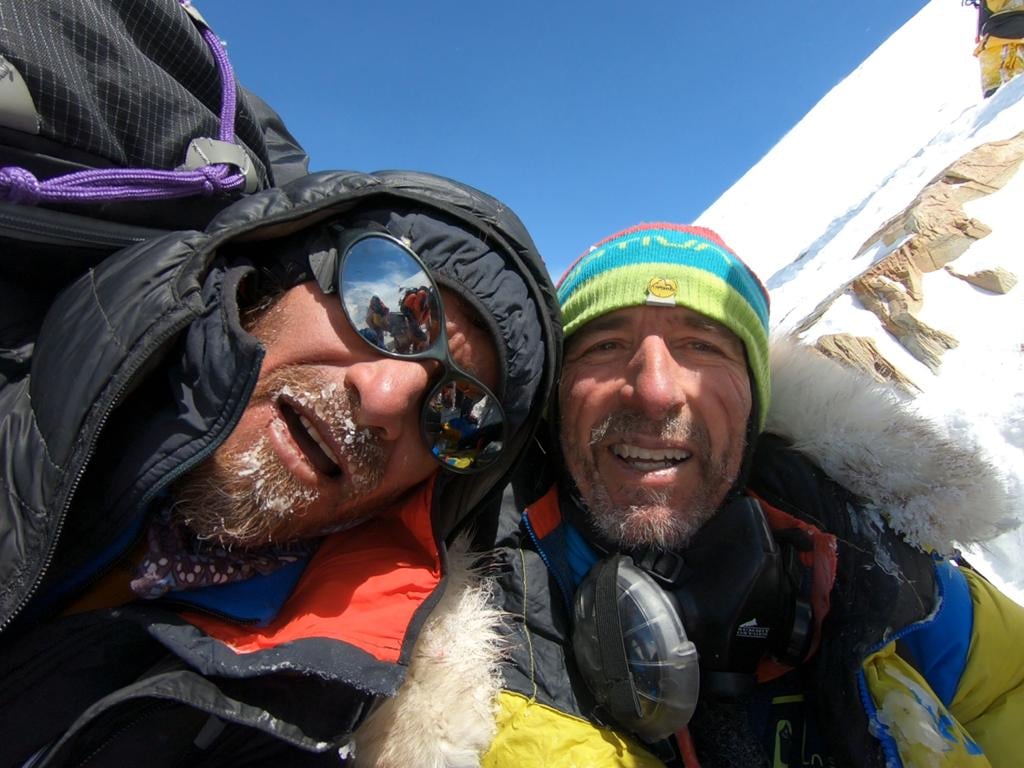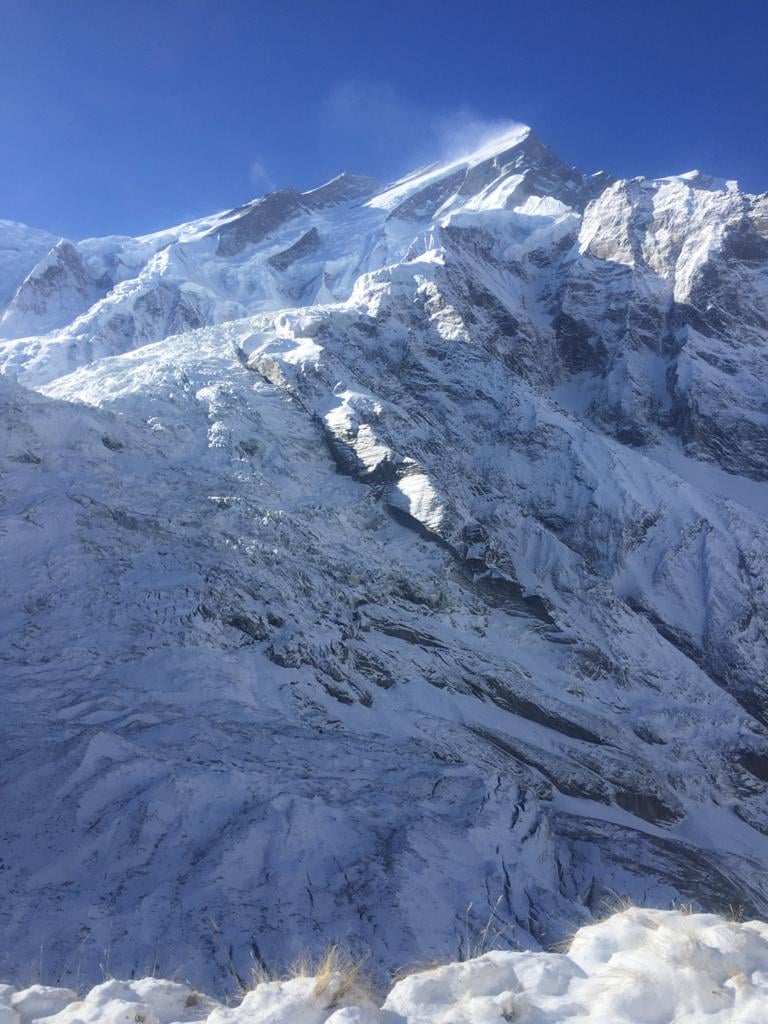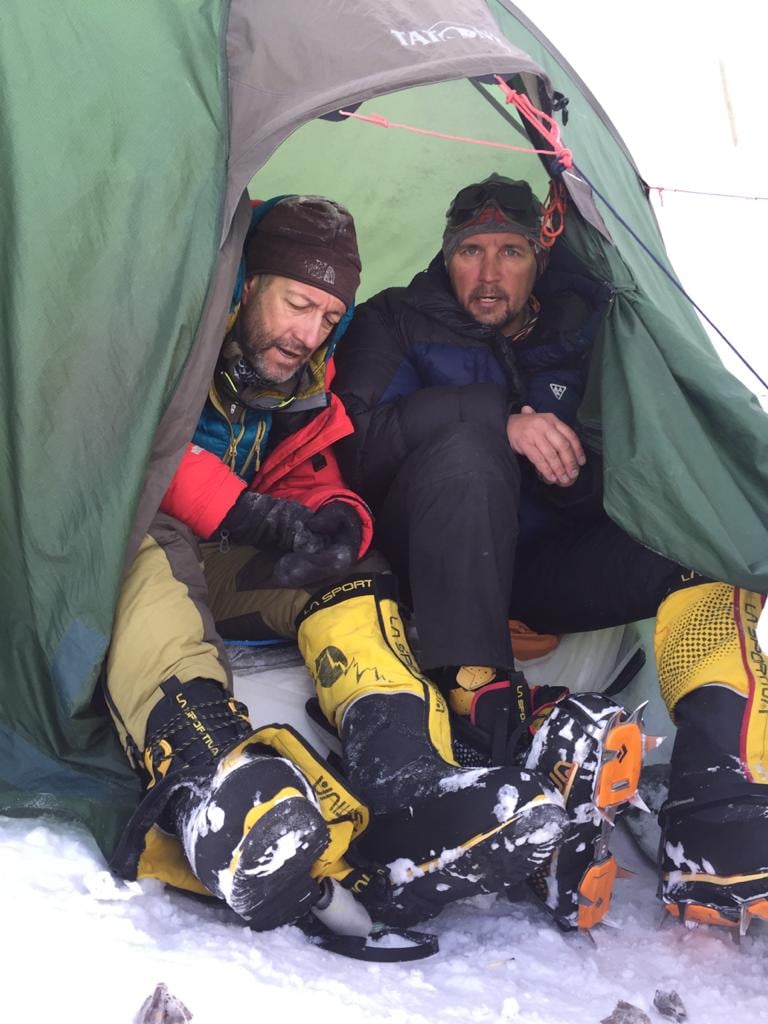

Annapurna. Sergey Kondrashkin: the story of the climb in April 2021. (English version.)
I'd like that suspense flashes don't change the narrative genre, but in the natural environment there is no insurance against this. This spring, after a break (as long as the pandemic), I was going to the big mountains, namely Pakistan for Broad Peak and possibly K-2. I was going to climb with my permanent mate Viktor Koval. In the beginning of March, I was in correspondence with the host party, the flight was scheduled for June 10, when Victor said that he would not be able to fly for family reasons. I remember that Dmitry Sinev called the other day with an offer to go to Annapurna. He persistently talked about alternative ways to get to the top. One of them is through a rock horseshoe that leads to 7000 m, bypassing the terrible ribs with overhanging seraks between the C2 and C3, using, in part, a French thread from the 50s. I looked at several pictures of the horseshoe and seraks images from different years, the relief itself changed slightly. Significant and diverse in this area, with all the evidence, were the options for avalanches. I nodded, and said that it is necessary first of all to look at the route "live", then to acclimatize, ideally reaching to the top via the normal route, and then you can consider the option.... (I initially did not believe in the possibility of going along this route. There are too many unknowns: from the vicissitudes of the terrain to the condition of the mates. It was clear that all the tasks of passing technically difficult sections were delegated to me, and in case of unforeseen situations, I can not count on their help due to the fact that we never climbed together. (the situation where it's not enoughbeing good and kind).
I met Dima Sinev in 2015 (even then he was inviting me to Annapurna). Since then, we have met a couple of times in urban settings, discussing possible joint plans. I liked him, a nice person in communication, simple and without fuss, except for an exaggerated romantic mood in relation to "paths leading to the top". I did not know Alexander Lutokhin at all (and I gradually discovered his personality). At that time, their duo had 20 years of experience, and 12 expeditions to 8000+ , including successful ones to Manaslu, Broad Peak and Dhaulagiri, and this attempt to Annapurna was the 4th in a row. Tickets were taken for March 25, and on March 26 we are already walked through Tamel, which is extremely deserted, but soaked in a familiar specific bouquet of incense, spices and a deep woody aroma. March, 27 in the morning we leave for Pokhara, and the next day we arrive in Tatapani. Tatapani means "warm water". A small village at the bottom of a mountain gorge, with a couple of hot springs equipped with baths. Original baths with a healing effect. The local population comes here in families: a radja-like head of the family with a luxurious mustache, a brood of kids and a few women in saris, and a couple of very ancient grannies warming their feet in the hottest part of the spring - the regulars of the baths. There are a couple of observation decks to climb up to. But from there you can partially get the impression of Annapurna, thus dividing it into parts, so as not to break with delight later. Only on April 2, when we almost regretted that we did not go to the BC in a 3-day trekking, we were given a helicopter to Base camp. Only after taking off from Tatapani, we fly into a narrow gorge with steep slopes, closed by fog deep below. The base camp is located on a flat area (like a terrace) of the Nilgiri slope. A large terrace, convenient for helicopter landing, is surrounded by a river that dries up at night, which is collected from small waterfalls scattered around the perimeter. Located at 4000 meters, right side of the terrace abruptly drops into the abyss of the gorge, while the Annapurna top, leaving several huge steps, sits 4 kilometers higher vertically. The massif is truly gigantic in size, comparable only to Nanga Parbat (8125m), where the base camp on the Rupal side stands at 3700m. Even the Everest massif (the drop from the foot to the top) isn't so huge. At a student party at the Academy of Arts, in a noisy international company, my friend's wife, a Chinese woman, said that it was easy to be with us, Russians.
"Why?"
- It's simple: if you like something, you say-Yes, well, I like it. And if you don't like it, you say No.
"What about you?"
"Ah, we will always say Yes, but you must understand its meaning. The East , in any way, requires you to look behind the scenery with objects and inscriptions and feel the authentic conditions. No matter how good the SST( Seven Summit Treks) intentions were, but I didn't not imagine options for re-fixing the route after the first heavy snowfalls. Once at the Base Camp, we finally understood it: the season will end after the first snowfall. This means that acclimatization (for our oxygen-free team) will be insufficient, and for safety reasons we need to join the main team of oxygen climbers in summit day. And, most likely, we'll have only few nights in camp-2 (5500 meters) and will go into summit bid, carefully observing our own condition and hoping for the accumulative effect of the high-altitude experience acquired over the past years. Morning, April 4- the ascent to camp-1 (5000 meters). After an hour and a half of the journey, at "crampons point" and the first steep 50-meter descent, it turned out that Dima (Dmitry - E.L.) did not take his descent device and jumar, apparently due to an overabundance of professionalism... and by a strange coincidence, on the same descent, an inattentive Sherpa droped stones to Dima. Hearing the noise, Dima abruptly jumped to the side, etching the rope in his palms. The result: burnt palms and fingers, skin torn off. On the way up to the Camp 1, I gave him my jumar. I go up, attaching by carabine to the fixed rope. In a couple of places, you have to strain yourself. We've reached the place in 5 hours. A great flat spot, lit by the sun, even with a stream on a small stone wall, where you can get water while it's warm. As for the weather, it is stable in the region. Small fluctuations are shielded by the Nilgiri massif, and so a stable sun from morning to 1-2 pm, followed by a couple of centimeters of snow to 18, and a starry night sky make up the high, spring season!) April 5: at night, I have a little headache, wake up, drink citramon. When the body begins to acclimatize, first of all, the non-viable urban whims are displaced. They separate like the rocket stages with burnt-out fuel. (maybe because "urban whims" don't burn in a mountain atmosphere?) In any way, but obviously difficult conditions of survival reduce the task (number of goals) to a minimum, leaving a couple of the most important ones. The rest is cleared from the consciousness, making it light, as if flying. That's why all climbers have such a clear, easy look!)
We woke up not early, at 7 am. The journey will be short, but very hot, if you do not get out before the direct rays of the sun touch the slope. We've been preparing for a very long time. In this situation, this is not critical at all, and I do not yet attribute it to the established tradition within the duo of my "senior comrades". We leave almost simultaneously, Alexander and me in front, Dima in the line of sight behind us. After a kilometer on a steep slope, we wait Dima for about an hour. There's no point in rushing - he brings our tent. The weather is fine, but only until one o'clock in the afternoon. Then necessarily clouds and snowfall. (It turns out Dima had to go back for the gloves.) We quickly take off to 5,500 m-the height of C2. I get there first and dig out the site for the tent. Here I meet Georgy with Pasang Sherpa. They camped a couple of tents away from us. Georgy is also from St. Petersburg, it is strange that we did not meet each other until this moment. The community of high-altitude mountaineering is quite small. We all cross paths in one way or another in the different expeditions. But all pleasant meetings once happened for the first time. Not an exception was the acquaintance with Israfil (Israfil Ashurly - E.L), with whom my companions have already managed to climb before". Mosses Fiamoncini, who, like us, used the SST services, left the base camp today and was now digging the site above us. In general, at the moment there were 12 tents in C2, and a clear day allowed us to assess in detail all the steepness and danger of the way between 2 and 3 camps. Starting from the traverse of the flat part of the step, located under the overhanging seraks, and a large avalanche outflow, updated a couple of times a day, crossing the approach to the steep part of the buttress - the "key of the route". It was a little comforting to know that tomorrow we would go down, and would climb this section in the next rotation.
Oddly enough, I slept better than the first night, even without the citramon. On the morning of April 6, we quickly run down to the base camp in time for dinner and before the precipitation. Now the plans include the rest on the 8th, and the exit Apr, 9 direct to C2. The weather is stable-good, only the snow flags blown on the top indicate that the wind is increasing at times. According to forecasts, Apr,15-16 are the best days for the summit bid, followed by snowfall. This means the end of the season. All "oxygen fans" are tuned in for these days. This is our chance to climb as part of the "oxygen group", securing with common safety net, since our acclimatization is clearly not enough for such a serious mountain. On April 9, we proceed according to the plan: early exit and overnight in C2. We go slowly, but in terms of the amount of time on the segments between the camps, it goes faster by one and a half times than on the first push. This evening, the snowfall is more abundant than in the previous days, and there were several large (judging by the rumble) avalanches during the night. The next morning, two Frenchmen who spent the night in a cave at the level of the upper pillow told about avalanches that blocked the lower part of the route. We decided not to fuss and not to test the strength of the slopes that day, and returned to the base camp. April 11 the rest in BC. Such days are filled with serenity. This is the gap between the time you worked out and possibly risked and the upcoming portion of the unknown. Of course, there is a fairly accurate plan... but as Goethe wrote: "Theory is dry everywhere, my friend, and the tree of life is luxuriantly green."I watch the Sherpas perform another Puja, and I hope that the tree of our lives will continue to delight us with its lush flowering. The push is scheduled for tomorrow, and it will be a summit bid. Everything we need is already in C2, everything except the acclimatization. But , in the end, if we wouldn't be able to go up - we will turn down. Fortunately, we will not be alone on the mountain. The first half of the clients chose April 15 for the Summit day, and the second half chose the 16th. The first option is not for us - we just do not have time to rest. In addition, on the 16th, the trail will be packed with a guarantee. 12-April: early start, before the sun gets hot, we pass an unstable area under the first stage of the icefall, then take off along the ram foreheads of the buttress that leads through the snow field to the first camp, and then go to camp-2. Already at 1 pm I'm on the spot. I see that the Greek Antonios has gone to C3, which means that his tent is at our disposal. I get in, boil the water. During these days, I have lost a lot of weight, despite the fact that the highest loads are still ahead. You should drink more, and eat as much as possible.. An hour and a half later, Sasha comes, and an hour later, Dima.
Georgy, having already spent here the previous night, says that his sherpa advises not to rush and stay in C2 for two more nights. But he's got oxygen, and he's got his reasons. According to the plan, we should have enough time for a climb from camp 3 to Camp 4 and back, one day. A little confusing is the fact that the height of the 3rd camp is only 6500, it is just above the level of camp-1 on Everest. In 2010, valiant Valery Shamalo and I attempted to climb Mount Everest in the off-season (in summer). In order not to pass the Khumbu icefall once again, we settled C1 and acclimatized from it... as a result, 10 days after we arriving at Everest Base Camp, we climbed to the South Col (about 8000 m) and descended safely. Remembering this adventure, we are now determined by the entire out sports team. April 13, wake up in dark at 4: 00 am. We begin to get ready, prepare breakfast and at 6:30 we slowly move out. a 30-minute smooth take - off and transition to the left along the flat top of the icefall stage under the giant wall of overhanging seraks, and at the top of the vertical-framed rock horseshoe. From here you can see the entire kilometer of the vertical take-off of today's path with endlessly overhanging alarming ice masses. To the right of our buttress is the same height smoothed stone trough with a huge fresh avalanche outflow, which we pass at a brisk pace in 20 minutes. Next, the vertical part is unsafe, since it is also swept by snow and ice masses in the event of large landslides. The first 2/3 of the take-off I go well, then suddenly I feel tired, and, according to the sensations, the pace drops by 1.5 times. However, after 5 hours, I'm on the place. I immediately find Mosses ' one-man tent. He plans a summit push on the 15th, i.e. tomorrow he will go to C4 (6900m). He shows me where Israfil is located in the four-person "north face" tent. I climb to it 20 meters higher, avoiding deep cracks. The camp is located on a steep slope framed by a vertical ice take-off in the upper part, and randomly sticking out of the slope just below the ice teeth 5-10 meters height, forming a maze, under the walls of which it is convenient to place tents. Israfil invites our trio to spend the night in his tent. I do not need to be persuaded, and I am also sure of my partners. I settle down, pull out food and things, wait for the "gornyashka" (AMS - E.L.) to roll in, but I feel good. We boil the tea, after 2 hours Sasha and Dima come up. They also do not look very tired, which means that we continue to work according the plan. Israfil decides to join our walk tomorrow. April 14, morning pandemonium near our tent. A live queue was formed for the fixed rope through the vertical section of the ice wall leading to the snow cushion. We're no hurry today. We put the tent on the newly vacated place of the group of Sherpas who went up, and go out after the last line of oxygen climbers. Movement on the pillow is safe, only in a couple of places large stones rush past us, separating from the overhanging wall to the left. The main group stops at the 6900 m - their C4- highest camp. For those who go with oxygen, the issue of heating is solved by a little more of its consumption. They can afford to go out at midnight, catching the coldest time. Therefore, this height is acceptable for them. We must adhere to a fundamentally different strategy, and tomorrow we plan to camp at 7300 m. Our today's walk is only acclimatization. No one ascend above 6900 on this day. For tomorrow's attempt, the ropes will be fix as the main group moves up. The method is very unreliable, because there may simply not be enough time to fix in difficult places, and everyone will have to turn. By one o'clock I was down at camp-3 . Israfil decided not to force, but to spend the night in the C3 and go down to the BC to rest.
"It's too big a mountain to attack from the second push." I fully agreed with him, but I could not let go of the feeling that our only option is linked to the weather window, and closing it will mean the end of the season. Georgy and his Sherpa had come up from below and were now resting in the same tent with Israfil. I was sitting at the entrance to their tent, and we were talking, when there was a pop, characteristic of breaking ice, and the slope below us sagged a little. We looked at each other, at this moment most of all I wanted to be in another (any other) place, preferably on Phangan, but Kupchino (Saint Petersburg district - E.L.) would also be suitable. For a few tense seconds, we waited for another crack and even its consequences, but it was quiet. Inside, everything was rushing, but there was obviously nowhere to run. - The main thing is that any actions now are useless, it will either happen or not.
"We all walk under God," Israfil said with special care.
"We need to ask Pasang if there is anything to worry about," George's voice came from the tent.
At this very moment, Pasang opened the tent with a sharp movement and looked at us, his Asian eyes wide open, but I could not see the answers to George's questions in them. On April 15 we woke up at 4: 00 a.m. We have to gain 800 meters in the vertical, set up a camp and manage to rest before tomorrow's attack. This is all under the condition of normal health. It is possible to start only at 7: 00. I take the tent and the shovel, since I'm guaranteed to get there first. When I reach 6700m, I meet the first Sherpas going down. They say that no one has reached the top today - it was not possible to fix the ropes till the top. When I get to 6900 m, everyone who went to the top today has already rested in their tents. Many planned to try again tomorrow. Mosses, in whose tent where I left the gas yesterday, looked bad, I mean, very tired. Being a healthy guy, he planned to go without oxygen, and we were in equal acclimatization conditions. But he had bet on the wrong Summit day and was now exhausted. I took the balloon and said goodbye to him. He said he was staying here tonight, and if he had the strength, he would try again tomorrow with us. I climbed the steep ice rise and disappeared behind the bend where the snow cushion transforms into an icefall. After passing through a long ice corridor, I came out on a huge snowfield, walked a couple of hundred meters to the first bergschrund and began to dig a site for tent. There was a lack of oxygen, I quickly got tired and often took breaks. I wanted to quickly climb into the tent and relax, stretching out to full height in a warm sleeping bag. The platform turned out to be small, even insufficient in length, but I didn't care. I pulled the tent out of my backpack, inserted the arc, and put my foot on the awning so that the structure wouldn't fly away. The clouds had settled on the top, and the snow and gusty winds made the conditions even more unbearable. I start to insert the second arc, when suddenly it bursts at the junction. No through holes appeared, so I leave everything as it is, propping up the entrance vestibule with a telescopic stick. I quickly take off my shoes, throw my inner shoes and mittens into the sleeping bag, and pass out. I wake up in an hour and a half. I critically assess the insufficient dimensions of the site. It is necessary to expand the tent and dig a little in width. I get out and work for about an hour. My companions are not visible. Thunderclouds are occasionally illuminated by lightning bolts. I hope they'll make it before dark, or they'll cut their rest time to the limit. In the tent, I boil tea, sometimes falling asleep. At about 16 o'clock Sasha came up and an hour later Dima. I justify them only by the fact that they are saving their strength for tomorrow's breakthrough, but frankly, I am beginning to be piss me off by their unhurried manner (as if camouflaging the lack of strength and unprofessionalism). But it's good that we got there, I feel pretty good. We drink for an hour, our gastronomic preferences this evening - Chinese instant noodles, one pack for three, we can't eat more. I set the alarm for 3: 00 in the morning and immediately fall asleep. On April 16, we will go up with an alarm clock , it is still dark and the oxygen team is not heard, and it's rashly for us to start before them . Preparing breakfast. The guys, as always, start looking for wet mittens, scattered from the evening. I, of course, am extremely spoiled on the climbs with the professionalism of my friends and permanent partners Victor Koval or Nick Totmyanin, and I take many of the organizational, and even more so self-organizing, moments for granted. When I lead clients, I turn on a special mode for them - total control. Here, it seems that my mates are experienced, and they did not pay to control themselves, but they did not learn how to collect the" ass in a fist". Around 5 am, the first attackers began to pass by the tent. I was already pulling on my inner boots when Angelo (Angiolo Laviziano, an American from our group(SST)) asked to rest in our tent. He was walking without oxygen and managed to freeze his feet. He looked tired and dehydrated. Dima somehow thought that Tom needed additional help and a brand-name Russian heating with a warm heart. He took off Angelo's shoes and socks and put his feet on own chest. I tell him that it looks like a kindergarten, and Angelo is an adult climber. I climb over them into the vestibule, dress the crampons, and go out after the first half of the oxygen group. It was dawn by the time, but the sun wasn't high enough to start warming the slope. We move slowly along the wedge-shaped stone ridge, then a long gentle traverse under the rocky part of the summit bastion to the steep snow couloir leading to the summit. This couloir is the last 200 vertical meters of takeoff. I walk at the same pace as the group. Georgy follows me with Pasang and Pemba. I try not to lose sight of him. On one of the steep sections, I watch as a few people in front slowly move in a dense group and a little further to the left, a creature with legs like a bird, wings and an open beak smoothly dances. And everyone wants to touch it. The nature of visions is such that you cannot abstract from them as from a meaningless picture, because these images are like a funnel that draws in your thinking and feelings. The mind switches to a dream-like mode, taking any plot twists at face value. At that moment, my attention seemed to split in two. One half sees a dynamically changing world with a dancing bird-man, an emerging tent with oxygen supply from which music can be heard, and everyone walks around peacefully and has casual conversations . And the other half critically assesses what is happening, keeping the focus on the goal and safe ways to achieve it. 20 meters before the top, the space becomes viscous, and everything begins to slow down. The people in front of me froze and stretched out their hands to the sky. I could hear their words clearly:
- This is "HE" ( obviously the deity, the source of everything), let's drink the power "HIM."
The multicolored silhouettes merged into a single body stretched out on the slope, it expanded and narrowed in time with my breathing. I felt a part of it. I looked down and saw the same picture, the same pulsing shapes frozen in place.
- Georgy?! I called, unable to make out the faces in the oxygen mask.
"I'm here!" "he was standing right behind me . For me now, he's a real beacon in the world of sanity.
"What's going on?"
"All's OK, let's go."
So it's all right, so let's go.. everyone just got up to rest . 20 meters to the top, somehow I'll make it. I climb out on the rock-the top landmark, where Antonios (Antonios Sykaris) sits. I'd love to take a break with him, but I have a feeling that I need to go down immediately. I ask him to take a couple of photos. We congratulate each other, swallowing the words from shortness of breath. I hug him, Georgy, and began to go down. As soon as possible. All attention is focused on the accuracy when re-attaching the belay. I walk so that I don't get out of breath, but my breath comes out of me at times. At the bottom of the couloir, I walk around the person going up.
"How are you?" he calls out to me .
- Normal -I look at his face , it does not cause any associations.
"Don't you recognize me?"
- no.
- It's me, Dima!
Only now I find out, as if recalibrating the settings. I need to tell him to be careful, to turn back if he feels bad, and some words - for example - it's not so long till the top already... - complete nonsense !
"I don't feel well, so I go down."
"See you later in the tent," he says. As me descend, it becomes easier to breathe, but in the lower part of the traverse, fatigue rolls in. However, I go without stopping. The most important thing now is to throw off the height as much as possible. When I reach the tent, Sasha is already sitting inside. He had wet mittens on the ascent, and this flaw robbed him of the chance to climb. His hands were frostbitten the skin was peeling off, and his fingers were pretty black. I melted the snow, and we drank. I wasn't hungry. Sasha climbed into the sleeping bag, crossing his arms and warming his palms in his armpits. We won't be able to go down today, we need to wait for Dima, and we don't have enough energy. In addition, the tent was covered with snow at night, and it was torn even more. I pass the broken segment of the arc through the ice drill. It works like a tire, returning the vestibule almost to its former shape. I dig out the tent, now there is a chance that it will live until the morning, but we will not take it away. Dima returned when it was already dark, and sat for a long time without removing the crampons, sticking his legs out of the tent. Then he gathered his strength and kicked off his boots. I didn't see if he'd taken off his inner boots or not, and I was only energy enough for myself. After all, he had been in such situation before, and he should understand. I was coughing violently, having picked up the cold air. We need to rest now, and tomorrow go down as much as possible.
April 17: We woke up at 5: 30. all night the snow swept the slope, and a snowdrift accumulated on one of the sides of the tent, finally broke it. In the morning we decided not to prepare breakfast or even drink, saving time for the descent. My mates gather incredibly slowly. After an hour and a half, I can't stand it and, throwing my backpack outside, I climb out myself. Standard move for mobilising forces (Standard teamwork). The first one gets out to make it easier for the others to gather. Those in turn hurry up, so that the first one does not freeze. As a result, I wait outside for about 2 hours. From time to time, waving away the frozen legs, I understand that I need to move down. Maybe this will serve as an example for them. I don't have the strength to collect everything for them, and I didn't count on it (actually, like many other surprises)- after all, they are experienced climbers...
- Guys, what took you so long? I'm cold!
"We're going to."
- How long can you fucking stay there?- The words sounded emotionless, just from the figures of speech, the form of the most sharp impact was chosen. - I'm off , catch up. I knew they were exhausted, frozen, and exhausted, but no one would come down for you. I put on my backpack, find a rope under the snow, and go down. At least I'll make a trail, at least some relief for them. An hour later, I'm at the place of common camp 4 (6900 m) from where the oxygen climbers started. By this time, almost everyone had left. A hundred meters below, there are several empty areas located next to each other, with abandoned caremats and a crumpled tents. There are also two Sherpas. I ask them for matches. They give me two boxes of leftovers. Lighters often fail at this altitude, and our matches are damp. I light the stove and start to melt the snow, hoping that my partners will come down in the next half hour. One of the Sherpas, Gesman Tamang, asks what is my plan? - I'll wait for my team and we'll catch up with you before the ropes are covered by snow.
We say goodbye and they quickly leave, driven by the beginning snowfall. I look up from time to time, and everything is still the same-no one. After 3 hours, fairly frozen, I inspect the abandoned tent. With the exception of small holes, it is intact. Looking around the upper platforms, I see abandoned racks, one broken, the other intact. No complicated compilation and the temporary shelter is ready. A crooked tent with flabby walls, and even a few thin gray caremats enough in area to cover it from the inside. It turned out quite tolerable, and even spacious . It was the fourth hour of waiting when a tired Sasha fell inside. I give him tea, he's exhausted. He says that it took him many time to put on crampons
- Where's Dima?
"He was still in the tent when I left.
- Call the helicopter , it's a real disaster.
In a few minutes, just the time of communication. Sasha turns on the radio, but its battery immediately runs off . The plot twist is like a cheap horror movie with a mediocre script.
There is nothing left but to wait for Dima. Today, remembering how events unfolded, I understand that it was necessary , without waiting for Dima, to go down, and perhaps by nightfall I would have reached camp-2, and from there I called a helicopter. But history does not know subjunctive moods.
After 3 hours, at sunset, Dima came. When asked what took so long, he answered - "Gornyashka" (AMS). In addition, he told the story of how, turning over, he fell into a crevasse, got his foot tangled in the rope and got out for an hour. No matter how romantic and exotic the reasons were, but today was lost, my well-being did not allow me to go down in the night (there is a high risk of frostbites), and the weather window, which pleased us with its constancy for 2 weeks, closed, and our temporary shelter was intensively covered with snow.
April 18: This night more than a meter of snow was attacked, the slopes were overloaded, and the rope was buried, so that when I went out in the morning in the hope of going down, I did not even find it. After walking in snow almost to the waist, 150 meters down, I repeated the attempt. In vain. In addition, the swollen slope was ready to come down at any moment. After assessing the risks, I turn back. The condition is painful, I often stop because of shortness of breath alternating with a high-altitude cough. ( I fall asleep as I walk, seeing vivid snatches of sleep. I stand for a while, staggering. I open my eyes , take a few more steps. It takes about an hour to get back). Today's plan failed. We are locked in, there is a chance that the snowfall will not be heavy in the evening, and the snow will settle by tomorrow morning. Then we can go down with Dima, so that he can belay me until the C3. Next, he returns along the well-trodden path, and I go down alone. The section between camp 3 and camp 2 is steep, and there is a chance that the snow did not linger on it, coming down in small dust avalanches, and the ropes did not break . But this could be verified only empirically. In the evening, the increased wind actively sweeps the tent with snow, it breaks, a meter-long vertical gap has formed. I make lacing from the strings issued by Sasha. Snow masses from the slope squeeze out tent from the site, reducing our usable area. In the evening, I go outside, throw off the snow and wave the lamp on, hoping that somebody will see it from below. An hour later, when it's completely dark, Dima comes out and fixes a flashing lantern on the edge of the tent. The idea is amazing. I often wake up in the night, but it's better to say, I often fall into a dream. Due to the weight of snow piling on me and the sagging ceiling, I sometimes feel suffocated. I carefully push the sides of the tent away from me, so as not to tear them. All my clothes and sleeping bag are damp, and sometimes I feel a trickle of moisture running down my back, and my body is pounding with a large shiver. One good thing in this situation is that Dima's lantern is flashing outside, and this gives us a chance to be seen from below. April 19. My body is dehydrated, and I'm terribly thirsty. Dima is closer to the exit, and he needs to boil the water. Once again, we discuss the details of the plan. Here Sasha says that he will not stay alone and we will go together - it seems he is not himself.
- Sanya, if we go out together, we will go for a week until the C2. This is absurd. Unfortunately, yesterday's plan is our only option. "I won't be alone.
- Dima will go down 200 meters with me and come back.
- I know you, you will go down to the bottom.
I'm tired of the childish bickering and in general:
"If you really think so, burn in hell." Then he thought he heard a helicopter hum somewhere. I looked out - no one. But there was hope. That would be the most desirable outcome. However, I packed a backpack for a self-guided descent. Dima was clearly slowing down with the starting. I wasn't in a hurry either. There was a chance that someone noticed the lantern and the rescue operation had already begun. Dima found a snow shovel and fastened it to his backpack.
- Go already, I'll follow you- I said, wearing crampons.
"Do you hear that?" I listened again, for the umpteenth time this morning, but now it really does sound like it. The sound is louder and clearer. Heli takes off from the bottom, with a suspension and a rescuer at the end of a 50-meter halyard. The rescuer is the familiar Sherpa, Gesman Tamang, asks who is the first. First was Sasha, he is the most injured. Then Dima, each takes 20 minutes. My turn. Gesman snaps my harness and chest loop to the halyard and the helicopter pulls me off the slope. My body instantly relaxes, and I see the steep slope rapidly receding, which, thank God, I don't need to go down today. After 8 minutes, the pilot gently lowers me to the pad at the Base Camp three vertical kilometers below. And he flies off to pick up Gesman. I was quickly examined for frostbite. Waldemar Dominik Kowalewski notes :
-Yes, he is ruddy, like after a sauna ! It turns out that it was he noticed our lantern . The slowest climbers descended on the morning of the 18th. Waldi was worried about us, not knowing how to help. We didn't make radio contact, we were last seen on 6900, and nobody haven't heard from us since. He went up specially on the evening of April 18 to "crampons point", an hour's walk from Base Camp, with the expectation of arriving there after sunset. Only from there, in the dark, it was possible to see us by the light of the lanterns. He knew that if we were stuck on the descent, we would signal. The incredible confluence of circumstances that had trapped us at the height was resolved just as improbably. The chain of immaculate actions: Dima's lantern fixed on the tent, our friend Waldi, worried about us, which forced him, despite his fatigue, to go into the night to view the slope, and the quick reaction of Dawa (Chhang Dawa Sherpa, head of SST), who called the rescue board, without waiting for answers from the insurance companies, are the basis of our rescue and are the subject of my eternal gratitude to the people who committed them . ( Later we will learn the amazing story of Gesman Tamang, whose carbine attached off when taking off from the site at 6900 m . After flying 30 meters, Gesman fell on a gentle part of the slope, was able to stay and even did not hurt himself. The pilot felt a jerk, noticed the place of his fall, and immediately picked him up, bringing him down unharmed) We, 2 hours after the rescue, were already flying to Kathmandu and spent the next day in the hospital under IVs. I was diagnosed with pneumonia, which passed in a week, Sasha had to amputate 3 fingers on his hands on 1-2 phalanges, and Dima slightly cut a couple of toes, without touching the bone. When I called them at Skliff (N. V. Sklifosovsky Research Institute of Emergency Medicine in Moscow), Dima asked if I had closed the issue with Annapurna?
"Of course! Is it possible to ask them, when I have not closed the question of winter Nanga Parbat for myself?
|
